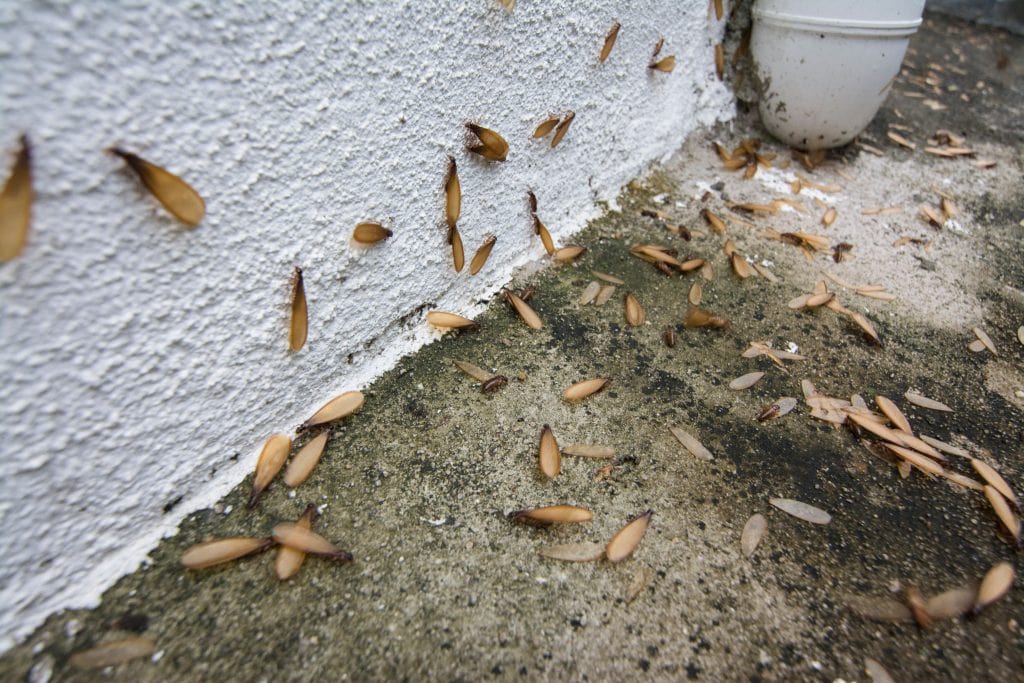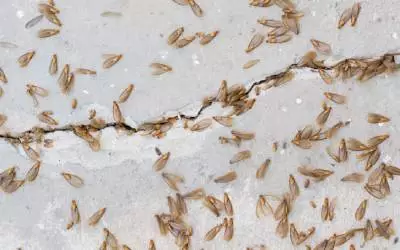What Do Flying Termites Look Like?

Table of Contents
ToggleWhat Do Flying Termites Look Like?
Flying termites, also called swarmers, are light brown or tan (depending on species) with straight antennae. They have two sets of equal-length, white, translucent wings with veins. Their thick body lacks the pinched waist of an ant. They're typically 1/4 to 3/8 inch long.

Physical Appearance:
Size:
Flying termites typically measure between 1/4" to 3/8" in length.
Color:
The color of flying termites can vary depending on the species. They may appear light-colored, dark brown, or even black.
Body Shape:
One of the key features of flying termites is their thick body with no pinched waist, which distinguishes them from ants.
Wings:
Flying termites have two pairs of equal-length, translucent wings with visible veins.
Antennae:
They possess straight antennae, which is another distinguishing characteristic.
Differentiation from Flying Ants:
| Feature | Flying Termites | Flying Ants |
|---|---|---|
| Waistline | No pinched waist | Pinched waist |
| Antennae | Straight antennae | Elbowed antennae |
| Wings | Equal-length, translucent | Unequal in length, opaque |
What Do Termite Wings Look Like?


Flying Termites vs Flying Ants

What Are Flying Termites?
Flying termites, often referred to as "swarmers," are reproductive members of a termite colony. Unlike worker and soldier termites, which are typically sightless and pale, swarmers have wings and are dark-colored. They emerge from mature termite colonies in large groups during specific times of the year, typically in spring or fall, depending on the species and environmental conditions.
Role of Termite Swarmers
Swarmers play a crucial role in the reproduction of termites. Their primary objective is to establish new colonies. Once they emerge from the nest, they embark on a brief flight to find a mate. After mating, the male and female swarmers land, shed their wings, and start the process of building a new colony together. This process is crucial for the expansion and survival of termite populations.
Lifecycle Stage of Flying Termites
In the lifecycle of termites, swarmers emerge during the swarming season, which typically occurs in warmer months. This period varies depending on the species and environmental conditions. During this time, mature termite colonies produce swarmers, which leave the nest in search of a mate and a suitable location to establish new colonies.
- Swarming Season: Swarmers usually emerge during warmer months, often after rainfall, when environmental conditions are favorable for their flight.
- Role in Reproduction: Swarmers are tasked with finding a mate and establishing new colonies, ensuring the survival and expansion of termite populations.
- Wing Shedding: After mating, swarmers shed their wings, as they are no longer needed. This distinguishes them from other types of termites.
- New Colony Establishment: Once a suitable mate is found, the paired swarmers land, shed their wings, and begin the process of building a new colony.
Understanding When to Look for Flying Termites
Swarming Season:
What is Swarming Season?
Swarming season refers to the time of year when termite colonies release winged reproductive termites, also known as alates, to establish new colonies. This is a crucial phase in the termite life cycle and typically occurs during specific times of the year, varying depending on the location and species of termites.
Variation Depending on Location and Species
Swarming season varies based on geographical location and the species of termites involved. In warmer climates, such as tropical regions, swarming season may occur year-round. However, in temperate climates, it often happens during the spring or early summer months when conditions are favorable for termites to mate and establish new colonies.
Warning Signs:
Indicators of Swarming Activity Indoors
- Presence of Shed Wings: One of the most noticeable signs of potential termite swarming activity indoors is the presence of discarded wings near windows, doors, or other entry points. These wings are typically shed by the reproductive termites after they mate, indicating that a colony may be nearby.
- Mud Tubes: Another warning sign is the presence of mud tubes along walls, foundations, or other structural elements. These tubes are constructed by termites for protection and moisture retention as they travel between their colony and a food source.
- Visible Damage: Visible damage to wooden structures or furniture, such as hollowed-out wood or sagging floors, may indicate an ongoing termite infestation. However, this damage may not always be immediately apparent, and regular inspections are necessary to detect early signs of infestation.
What to Do if You Find Flying Termites?
Understanding the Urgency
Termites are notorious for causing extensive damage to wooden structures, which can lead to costly repairs if left unchecked. When you see flying termites, it often indicates that a termite colony is nearby, and they may have already infested your property. Ignoring this sign can result in further damage and potentially compromise the structural integrity of your home.
Inspection Recommendation
If you suspect a termite infestation, it's best to seek professional help immediately. Here's why:
- Expertise: Pest control professionals are trained to identify the signs of a termite infestation and assess the extent of the damage.
- Thoroughness: Professionals have specialized tools and techniques to conduct a comprehensive inspection, including areas that may be difficult to access.
- Customized Solutions: Based on their findings, pest control experts can recommend the most effective treatment plan tailored to your specific situation.
Taking Action
Upon contacting a professional pest control service, they will schedule a thorough inspection of your property. During this inspection, they will assess the extent of the infestation and recommend the appropriate course of action. This may include:
- Treatment Options: Depending on the severity of the infestation, treatment options may include chemical barriers, bait stations, or localized spot treatments.
- Preventive Measures: Pest control experts can also advise you on preventive measures to minimize the risk of future termite infestations, such as eliminating moisture sources and sealing cracks or openings in your home's foundation.
Frequently Asked Questions (FAQ’S)
Q. What are flying termites?
Flying termites, also known as alates, are reproductive termites that emerge from mature colonies during swarming season to mate and establish new colonies.
Q. How can I identify flying termites?
Flying termites have two pairs of wings of equal size, straight antennae, and a thick waist. They are typically light or translucent in color.
Q. Why are flying termites attracted to my house?
Flying termites are attracted to light, warmth, and moisture, which are often found around homes. They may also be drawn to decaying wood or other organic matter.
Q. Are flying termites harmful?
While flying termites themselves don't cause structural damage, they are indicators of a nearby termite colony. Once they mate and establish new colonies, the resulting termite infestation can cause significant damage to wooden structures.
Q. What should I do if I see flying termites?
If you see flying termites around your home, it's essential to contact a pest control professional for an inspection. They can determine if there is an existing infestation and recommend appropriate treatment options.
Conclusion
Other Termite Related Topics You May Be Interested In
- Bayer Premise: How To Use? Termiticide For Termite Control
- Anti-Termite Treatment Cost In India [2024]
- What if house failed termite inspection?
- What is WDO inspection - Wood destroying organism inspection
- Lethal TC: Chlorpyriphos 20% EC – The Ultimate Termite Terminator
- What Is Termite Treatment? Types & Methods
- What Do Flying Termites Look Like?
- What Causes Termites? Root Causes of Termite Infestation
- Termite Treatment For Walls – Complete Procedure
- Top 3 Termite Treatment Chemicals for Wood In India

